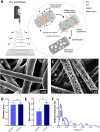Topographical influence of electrospun basement membrane mimics on formation of cellular monolayer
- PMID: 37225757
- PMCID: PMC10209110
- DOI: 10.1038/s41598-023-34934-x
Topographical influence of electrospun basement membrane mimics on formation of cellular monolayer
Abstract
Functional unit of many organs like lung, kidney, intestine, and eye have their endothelial and epithelial monolayers physically separated by a specialized extracellular matrix called the basement membrane. The intricate and complex topography of this matrix influences cell function, behavior and overall homeostasis. In vitro barrier function replication of such organs requires mimicking of these native features on an artificial scaffold system. Apart from chemical and mechanical features, the choice of nano-scale topography of the artificial scaffold is integral, however its influence on monolayer barrier formation is unclear. Though studies have reported improved single cell adhesion and proliferation in presence of pores or pitted topology, corresponding influence on confluent monolayer formation is not well reported. In this work, basement membrane mimic with secondary topographical cues is developed and its influence on single cells and their monolayers is investigated. We show that single cells cultured on fibers with secondary cues form stronger focal adhesions and undergo increased proliferation. Counterintuitively, absence of secondary cues promoted stronger cell-cell interaction in endothelial monolayers and promoted formation of integral tight barriers in alveolar epithelial monolayers. Overall, this work highlights the importance of choice of scaffold topology to develop basement barrier function in in vitro models.
© 2023. The Author(s).
Conflict of interest statement
The authors declare no competing interests.
Figures





References
Publication types
MeSH terms
LinkOut - more resources
Full Text Sources

